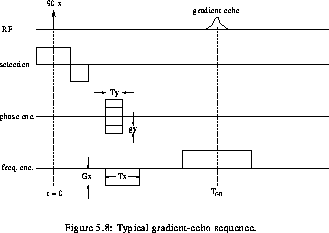
Using the same argument as previously, it can be shown that the reconstructed density produced by a gradient-echo acquisition (ge_seq) can be written:

where  is the echo time. Comparing with
rec_im, this shows clearly that gradient-echo, as
opposed to spin-echo images, contain a ``natural'' phase factor. In
other words, gradient-echo acquisition does not remove the effect of
field inhomogeneities.
is the echo time. Comparing with
rec_im, this shows clearly that gradient-echo, as
opposed to spin-echo images, contain a ``natural'' phase factor. In
other words, gradient-echo acquisition does not remove the effect of
field inhomogeneities.

Again, consider three acquisitions ( ,
, ,
, ) with echo time
of
) with echo time
of  ,
,  and
and  respectively. Choosing
respectively. Choosing  so that
so that  , the three acquisitions are given by:
, the three acquisitions are given by:
where  is a phase shift common to all acquisitions.
It can be shown that the water and fat images are
given by:
is a phase shift common to all acquisitions.
It can be shown that the water and fat images are
given by:

Note that these equations break down when  is an integer multiple of
is an integer multiple of  . In these situations however,
ge- to ge+ reduce to se- to se+
with the sign of
. In these situations however,
ge- to ge+ reduce to se- to se+
with the sign of  reversed and with an extra constant phase
factor that can be included in
reversed and with an extra constant phase
factor that can be included in  . So, one can always choose the
echo-time of a gradient-echo sequence so that the simpler equations of
the spin-echo case can be used to compute the water and fat images.
. So, one can always choose the
echo-time of a gradient-echo sequence so that the simpler equations of
the spin-echo case can be used to compute the water and fat images.